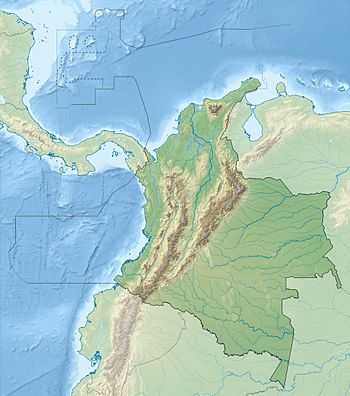Chingaza Natural National Park
| Chingaza Natural National Park | |
|---|---|
|
IUCN category II (national park) | |
 | |
 | |
| Location | Colombia |
| Coordinates | 4°28′N 73°44′W / 4.467°N 73.733°WCoordinates: 4°28′N 73°44′W / 4.467°N 73.733°W |
| Area | 76,600 hectares (189,000 acres) |
| Established | 1977 |
| Governing body | SINAP |
| Official name | Sistema Lacustre de Chingaza |
| Designated | June 25, 2008 [1] |
Chingaza National Park is located in the Eastern Cordillera of the Andes, in the northeast of Bogota, Colombia in the departments of Cundinamarca and Meta. The elevation ranges from 800 to 4,020 meters, and the temperature ranges from 4 °C to 21.5 °C.
Hydrography
99% of the park area is located in the Orinoco River basin in the upper basins of the Black and White, Guatiquía, Guacavía, Gazaunta, Gazamumo, Humea and Guavio rivers. 1% of its area is in the Magdalena River basin, where the San Lorenzo Creek, La Calera River tributary, and Teusacá, Siecha, Bogotá, and Tominé rivers drain.
Chingaza has about 40 natural glacial lakes. The largest lake is Lake Chingaza, located southwest of the park at an altitude of 3,250 meters. One of the most representative and culturally significant bodies of water is the Siecha Gaps, a group of three lakes in the municipality of Guasca. Chuza Reservoir is also located within the Chingaza Park in the basin of a tributary of the River Chuza Guatiquía. This reservoir is the center of the Bogotá Water Company's Chingaza System. Chingaza contributes 80% of the city's high quality drinking water.
Viewing and wildlife
The animals found in Chingaza include spectacled bear, deer, tapir moor, pumas, Andean condors, Cock-of-the-rocks, jaguars, turkeys, woolly monkeys, nocturnal monkeys, ocelots, and toucans. The large number of endemic species makes the Eastern Cordillera one of the most important geographic regions for wildlife in Colombia.
In the vicinity of the Chingaza lagoon, less than 383 species of plants have been recorded. It is estimated that the total flora of the park may exceed 2,000 species. There are eight species of peat moss, which can absorb up to 40 times their weight in water. There are also endemic species, such as frailejones, that grow even within forests.
Communities present in the area
Indigenous
There are currently no indigenous groups within the territory of Chingaza. However, the area has historical importance, with over 10,000 years of Muisca civilization in the region. Ponds, rock shelters, the mountains and especially the water were sacred places of worship and respect, forming ceremonial centers. Recent studies indicate that Chingaza Muisca language, could have been called Chim-wa-za, which means "God's Serrania de La Noche".
Peasants
The population around the park forms a rural community with its own forms of organization, dynamic internal and external relationships, and cultural patterns that distinguish it from peasant communities in other regions.
References
- ↑ "Ramsar List". Ramsar.org. Retrieved 12 April 2013.
External links
www.ramsar.org/sites-countries/the-ramsar-sites